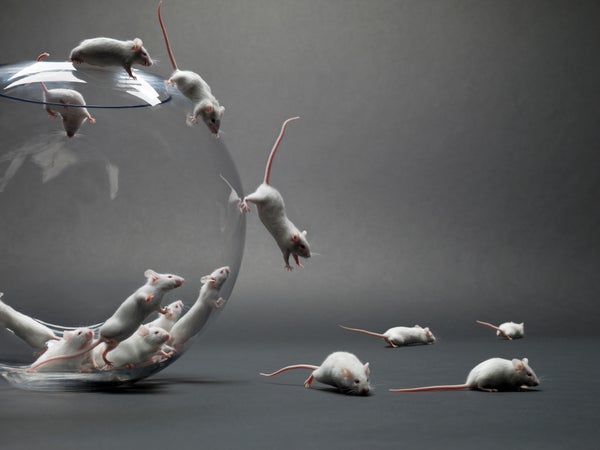Pinpointing where motivation resides in the brain is not easy, but a research team in China may have done just that. The group isolated a small group of neurons in the brains of mice that play a critical role in persistent behavior, according to a study published today in Science. This handful of brain cells is known as the dorsomedial prefrontal cortex, or dmPFC, and it sits in a region integral for learning appropriate social behavior. When the team fired up the neurons using light, the dmPFC motivated the mice to win competitions in which they had previously lacked the will to succeed. In other words, “this might provide a new biological basis for what people call ‘grit,’” says Hailan Hu, a neuroscientist at Zhejiang University who led the research.
In the case of these mice, “grit” requires upsetting hierarchies. Male mice that live together establish and maintain social rankings, Hu explains. To figure out which mice were dominant, she and her colleagues released two mice at a time into a narrow tube, one at each end. To get out, one animal—the lower-ranked individual—had to back up whereas the other, higher-ranking individual had to push forward. Most studies of mouse social hierarchy have focused on more aggressive behaviors such as how male mice might pick on new cage members, says Helmut Kessels, a neurologist at the Netherlands Institute for Neuroscience who was not involved with the research. “In this case it’s just four mice in a cage who live in peace,” he says, which helps strengthen the team’s argument that they were assessing motivation, not hostility.
In a previous study Hu’s research team used neuron-disrupting molecules to prove the relationship between dmPFC activity and a mouse’s decision to surrender to or push back against its cage mate in the tube task. But the technique they used for modifying the dmPFC’s activity levels took between 12 and 24 hours to work. “It was relatively slow for us to see a very direct causal relationship,” Hu says. This time around, she and her team wanted much more precise, instantaneous control of the brain region. So, they inserted a virus into the dmPFC that expresses a light-sensitive protein, along with a fiber-optic cable. When the team pulsed laser light through the wire, it instantly regulated the protein’s expression, turning the neurons “on” or “off.” With their prefrontal cortex switched “on” 80 to 90 percent of the treated mice pushed out opponents they had yielded to before the neural interventions.
On supporting science journalism
If you're enjoying this article, consider supporting our award-winning journalism by subscribing. By purchasing a subscription you are helping to ensure the future of impactful stories about the discoveries and ideas shaping our world today.
When the mice were placed in the tube chambers without any kind of brain intervention, those that had behaved dominantly multiple times the day before kept their ranking. The team suspected the mice had undergone a kind of neural circuit workout—the repeated winning had perpetuated their drive to win. An earlier study had identified the connection between the thalamus—a brain region that relays incoming signals from the muscles and senses—and the dmPFC, along with the role this neural circuit can play in modifying a mouse’s desire for confrontation. With that in mind, Hu and her team honed in on a region where the thalamus meets the dmPFC. Sure enough, activating that connection inspired the same drive to win. This detail of the research—showing this brain circuit can adapt to winning—is what really makes this study stand out, Kessels says.
The mice shifted on the scoreboard not because they were made bigger or stronger—the researchers paired up mice of similar sizes and measured no change in testosterone levels after the contests. Neither did the altered mice defend their territory and attack when new mice entered their cage, as they would if their aggression levels had risen, according to Hu. Mice adapted to winning showed their skills outside the tubes, too. When the team exposed cage mates to an ice-cold floor with one warm corner, the same social-climbing phenomena occurred. The newly dominant mice spent more time in the hot corner than they did when they were lower-ranking, even though their dmPFCs were no longer being artificially activated by Hu and her team. The findings suggest the experiments were truly testing the mouse’s drive to win.
Words like “drive” or “grit” sound like very human qualities, Hu says, but she thinks they are reasonable terms for translating the shift in mouse behavior to something humans can recognize. Kessels phrases the phenomena another way: The neurons of the winning mice have adapted to victory, he says, so they learn to expect a win. This trained anticipation could potentially help athletes or anyone in a competition, Hu notes. If you first face multiple opponents you easily beat, she says, you might be psychologically geared up to win again, even against a more challenging competitor.
